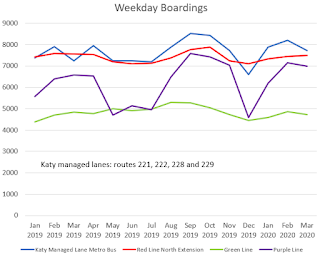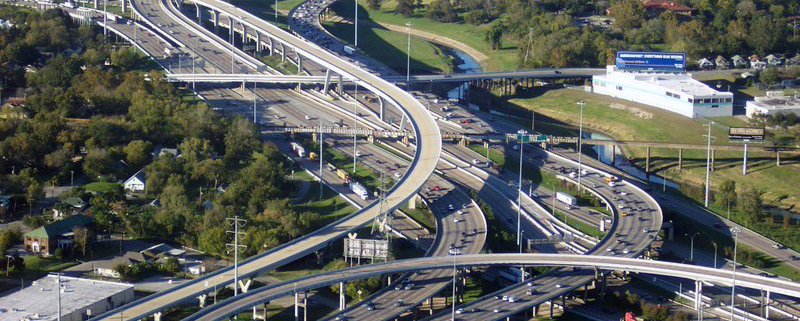The City of Houston’s Problematic Requests for the I-45N Project
This week’s guest post is by Erik Slotboom.
For the last 10 years the City of Houston (CoH) has worked as a partner in the development of the plan North Houston Highway Improvement Project (NHHIP). Now, within weeks or months of a record of decision on this plan — the I-45N project, CoH is abruptly changing its position and for Segments 1 and 2 is requesting drastic changes that are harmful to mobility, safety, and aesthetics. This blog post looks at the negative impact of the CoH requested changes for Segment 1, which is the section between Loop 610 and Beltway 8.
The main features of the CoH request for Segment 1 are:
- “Rebuild the highway within the current footprint as much as possible”, and “CoH favors remaining in the existing right-of-way in Segments 1 and 2”. Note that the existing right-of-way is unusually narrow, around 260 to 280 feet, between Crosstimbers and North Shepherd.
- “Current reversible HOV lane is replaced with dedicated transit lanes”, which are available only to “North Bus Rapid Transit [and] regional express bus service”, and the transit lanes “should include intermediate stations in the freeway”. Transit lanes are somewhat wider than the existing HOV and stations will require much more space than the existing HOV.
- “Design exceptions and lane widths and shoulder widths to keep the footprint within the current right-of-way”
- “Accommodate freight demand throughout the corridor”
This means that:
- The existing HOV lane is eliminated, so carpoolers, ride-sharing, and vanpools no longer have this option
- The planned managed lanes are entirely eliminated
- Design standards must be compromised to accommodate the dedicated transit lanes and stations, probably including 11-foot-wide lanes and narrow interior shoulder
- With no right-of-way acquisition, the narrow corridor will basically be fully paved edge-to-edge, drastically reducing opportunities for landscaping
Let’s take a closer look at the negative impacts of the changes requested by CoH
Very Harmful: Loss of the HOV lane for carpools and vanpools
Carpools and ride-sharing will be forced onto the main lanes, eliminating a strong incentive for carpooling and worsening traffic in the main lanes.
Huge Loss for Future Mobility: elimination of the managed lanes
Managed lanes are the most effective tool for providing options to freeway congestion and are widely used nationwide. Metro bus ridership on the Katy Freeway managed lanes exceeds all of the three most recent light rail expansions (see chart). The NHHIP managed lanes are currently planned to be toll-free but may be restricted to high-occupancy vehicles only at peak periods, providing a strong incentive for carpooling. The Katy Freeway managed lanes generated $22.5 million in revenue in 2019, an amount which is 33% of Metro’s (separate) 2019 systemwide farebox revenue of
$67.5 million. The CoH request to eliminate the managed lanes is a huge loss to the future mobility of North Houston.

Source. For comparison, segment 1 of Interstate 45 serves average traffic of 282,000 vehicles per day (average of 4 locations).
Wasteful Duplication: the dedicated transit lanes compete with the Red Line
When study of this corridor began in the early 2000s, the community said it wanted transit first so the $756 million Red Line extension to Northline opened in 2013 and Metro Solutions includes a $634 million extension to North Shepherd. Ridership has been low on the Red line, averaging 7,414 weekday boardings over the last 15 months, which is only 24% of the original Red Line on a per-mile basis.
New dedicated transit lanes on Interstate 45 will duplicate the costly Red Line and cannibalize its ridership, reducing the Red Line’s already low ridership. It is far more sensible for the Red Line to serve the local transit needs in the corridor, and for Metro’s BRT to operate on TxDOT’s planned managed lanes and serve longer high-speed trips, such as to Bush Airport and Greenspoint.
Lost Opportunity: Making the corridor more attractive
The North Freeway Segment 1 is not a scenic corridor. In fact, it is among the most unattractive of all Houston freeways (which is saying a lot), and this has always been a sore point with local promoters since it is the first thing many visitors to Houston see. As the CoH document says, “I-45 North is a major gateway to Houston”.
A narrow, fully-paved corridor as requested by CoH will maintain the unsightly status quo and leave virtually no space for landscaping. With the TxDOT plan, there are typically 30 to 40 feet between the main lanes and frontage roads, a perfect setting for landscaping. Consider the West Loop in Bellaire, where we now have a nice forest of trees between the main lanes and frontage roads. This is possible with the TxDOT plan, but not with the CoH request.In addition, TxDOT’s proposed plan is slated to remove 24 billboards. This will be a great improvement for the aesthetics of the corridor, similar to the improvement achieved with billboard removal along the Katy Freeway. If there is no right-of-way acquisition as requested by CoH, there is no need to remove billboards.
Contradictory Goals: “Accommodating freight demand throughout the corridor” and compromising design standards
Segment 1 is one of the main truck corridors for freight movement in Houston, and truck traffic is projected to increase 21% by 2045. The overall NNHIP corridor includes five locations in a list of the 250 worst truck bottlenecks nationwide, in ranked positions 8, 11, 13, 25, and 65.
For a corridor with heavy truck traffic, you generally want high design standards including standard-width 12-foot-wide lanes, ample and long auxiliary lanes for safe merging, geometric design which meets standards, and traffic moving at posted speeds outside of peak periods. The CoH request is the opposite of those needs.
Attention CoH Planners: frontage roads are not the same as city streets
The CoH request says “The frontage roads and frontage road intersections should be designed as city streets and not highways”, including lane widths (narrower) and off-street bike paths. This ignores the reality that frontage roads handle different situations than a neighborhood street. Vehicles exit from the freeway at high speed, and vehicles entering the freeway are increasing speed. Intersections must handle heavy traffic volumes, especially turning movements, and heavy lane weaving is normal. Furthermore, there are very few neighborhoods immediately along segment 1. Let’s be real: how many people are going to bicycle to a car lot, retailer or Gallery Furniture?
Right-of-Way Acquisition: CoH is no longer using a logical approach
CoH is suddenly hell-bent on preventing any right-of-way acquisition on Segments 1 and 2. While displacements are always unfortunate, this subject must be approached logically in terms of the existing situation, benefits, and costs. Items to consider include:
- The existing corridor width is very narrow between Loop 610 and North Shepherd, averaging around 280 feet but with some sections more narrow.
- The current substandard freeway design is partially a result of the existing narrow right-of-way, and staying within the existing corridor will greatly limit potential improvements.
- The overwhelming majority of displacements are on the west side, so nearly all properties are the east side are unaffected by the planned right-of-way acquisition.
- The overwhelming majority of actual acreage planned to be acquired is lower-tier commercial establishments like fast-food restaurants, car lots, warehouses and strip malls, many of which are old and unattractive.
- Residential displacement on segment 1 consists of 58 single-family units and 160 multifamily units. Considering that the corridor is nine miles long, this is not an excessive number of displacements.
- A similarly large right-of-way acquisition was needed for the Katy Freeway expansion. The corridor has boomed since the expansion completion in 2008, with substantial redevelopment along the corridor, including Crown Castle reaffirming its plans for a new headquarters building just last week.
- A wide right-of-way expansion (around 200 feet as planned) is only incrementally more disruptive than a smaller right-of-way expansion, such as 50 or 100 feet. This is because many properties along the freeway are less than 200 feet deep, and taking a narrow strip often requires the entire property to be cleared. I saw how this process works when I fully documented the US 290 corridor
property acquisition and observed how very narrow acquisition strips such as
25 feet frequently caused entire properties to be cleared. I observed the same pattern with the recent clearance for SH 146 in Seabrook, where a large number of properties were displaced for a relatively narrow strip of right-of-way. The conclusion to be made is that if there is going to be right-of-way acquisition, you might as well do the full planned expansion since the impact is only incrementally more than the impact of a narrower strip.
Conclusions
- The mobility benefits of NHHIP Segment 1 are totally eviscerated by the CoH request.
- The CoH request does serious harm to current mobility by removing the existing HOV lane.
- The CoH request compromises the $1.4 billion investment in the underutilized Metro North Red Line by introducing a competing transit facility alongside it.
- The North Freeway corridor is perhaps the most unattractive freeway corridor in Houston, and it will stay that way with the CoH request.
- TxDOT should reject the CoH requests for Segment 1, since the project goals will no longer be met by implementing any of the CoH main requests.
A logical path forward includes:
- Retaining the I-45N design as planned by TxDOT, but enhancing the landscape and architectural design to transform the corridor from one of the ugliest freeway corridors in Houston into one of the most attractive.
- Ensuring that all displaced residents have access to equal or better housing in their neighborhoods.
This piece first appeared on Houston Strategies.
Tory Gattis is a Founding Senior Fellow with the Center for Opportunity Urbanism and co-authored the original study with noted urbanist Joel Kotkin and others, creating a city philosophy around upward social mobility for all citizens as an alternative to the popular smart growth, new urbanism, and creative class movements. He is also an editor of the Houston Strategies blog.
Photo credit: Dhanix via Wikimedia, under CC 3.0 License.

 Dhanix, used under CC 3.0 License
Dhanix, used under CC 3.0 License
 Public Domain
Public Domain